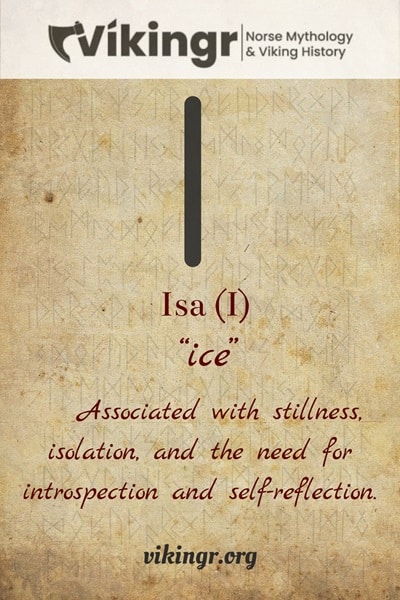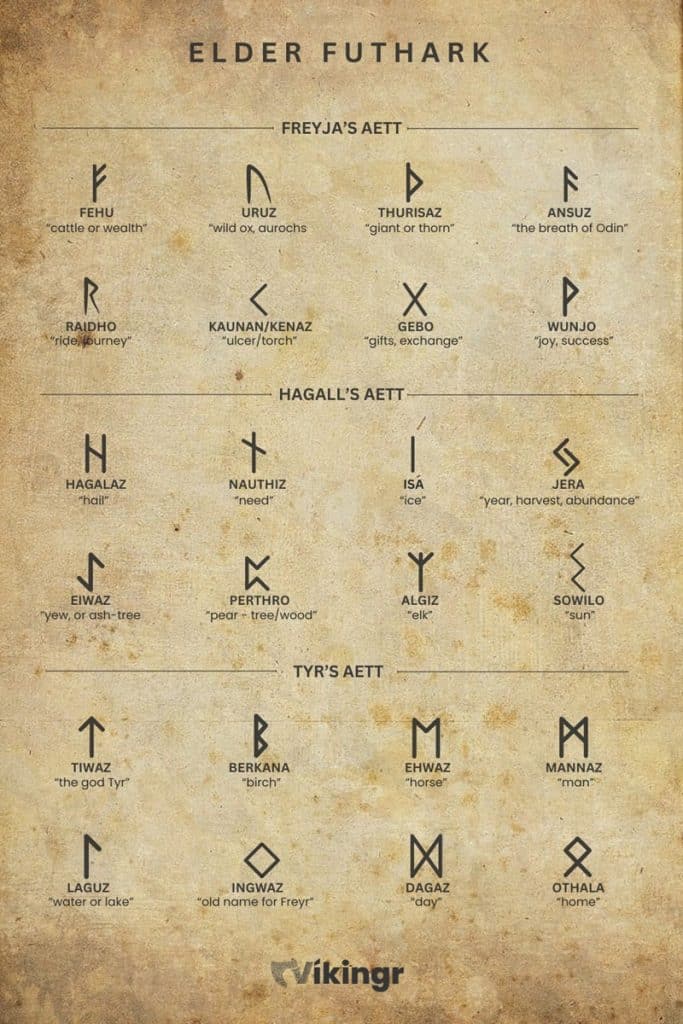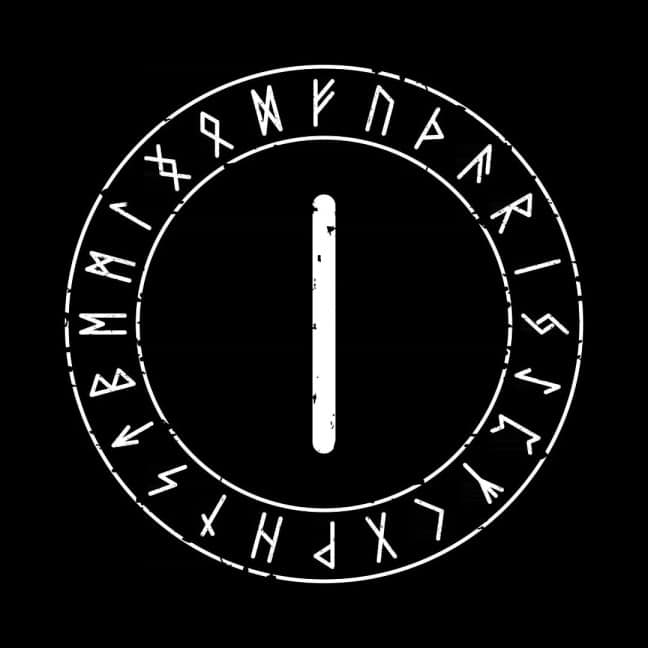In this post I am delving into one of my favourite runes, Isa, or īsaz. It’s the eleventh rune in the Elder futhark, and one of the runes that is also found in the Younger futhark. While calling favourites among the runes might seem silly, I’m drawn to its symbolism of ice and stillness, while also being associated with transformation. Persevere, even when things are stagnant, and great change can come. Just as water and ice shapes nature through time.
Isa – Background and Description
Starting at the beginning, with the Elder Futhark, the oldest form of the runic alphabets. It preceded the Younger Futhark which would become predominant in the Viking Age proper. However, this was a transition period of decades, if not a century. Isa, the eleventh rune in this sequence, follows Nauthiz and precedes Jera. The name comes from Old Norse, translating roughly to “ice.”
The Elder Futhark, the archaic runic system that Isa belongs to, was extensively used throughout Europe. From all across Scandinavia to the isles of Great Britain, and even reaching as far south as the coasts of Italy. It would slowly be replaced by the so-called Younger Futhark, coinciding with the beginning of the Viking Age.
The etymology of “Isa” is intriguing. Rooted in the Proto-Germanic “*īsaz,” it’s associated with ice as well as transformation, a common and significant element in the harsh Nordic environment. This gives us a glimpse into the mindset of the ancient Germanic peoples, showing us that they saw profound meaning in the natural world around them.

Graphical Representation
Visually, Isa is a simple yet elegant rune. Like an icicle hanging from a roof, Isa is a single vertical line.
Variations of Isa’s design have been found as the runes evolved through time. Some inscriptions show the rune with a horizontal line through the middle. However, the traditional form remains the most recognized and used.
Phonetic Value
In the Proto-Germanic language, Isa represented the sound “i,” as in “ice.” As Germanic languages evolved, so did the pronunciation of this rune. In Old Norse, for example, it was pronounced as “ee.”
Symbolic Meaning of the Isa Rune
Now, let’s delve into the symbolic heart of Isa. The Isa rune is associated with ice, stillness, and stagnation, symbolizing a period of waiting or a time for introspection.
The rune is also linked to potential and transformation, much like ice can melt into water or freeze into a glacier. It’s a reminder of the potential within us all and the transformative power of time and patience.
The Aesir Guardian God Heimdall is a central figure in Norse mythology, embodying vigilance and loyalty as well as the power of transformation. Isa, with its associations with stillness and potential, reflects these themes. Moreover it is offering a glimpse into the values and beliefs of the ancient Germanic peoples. Skadi, the Goddess of Winter, reflect the challenging yet transformative energies of this rune.

The Aett and its Symbolism
Isa belongs to the second aett of the Elder Futhark, a group of eight runes associated with the god Heimdall. This aett, or family of runes, carries themes of resistance, challenge, and the transformative power of hardship.
Heimdall, the vigilant guardian, and Isa, with its themes of stillness and potential, adds a layer of depth to this aett. It is reminding us that even in the harshest winter, there is a promise of spring.
Elder Futhark Quiz
Do you want to test your knowledge of Elder Futhark runes? Then this quiz is perfect for you!
Don’t forget to play our other games as well!
Isa Used in Divination and Magic

While I don’t personally subscribe to the practice of divination, I find the historical and cultural aspects of it utterly fascinating. In runic divination, many interpret Isa as a sign of stillness, a pause in action, or a time for introspection. It may suggest a period of waiting or a time for reflection.
We lack concrete evidence for specific spells or rituals, but it seems plausible that people invoked the rune’s associations with stillness and potential in magical contexts. Imagine a Viking etching this rune onto a talisman, hoping to bring a period of calm and introspection into their life.
In modern times, some practitioners of runic magic use Isa in spells or rituals aimed at inducing stillness, introspection, or a pause in action. Again, while I don’t personally practice this, I respect the cultural significance and personal meaning it holds for many.
Isa in the Younger Futhark – The Unaltered Stillness
As the Elder Futhark slowly transformed into the Younger Futhark, also known as Norse runes, around the 7th and 8th centuries, Isa, representing ice or stillness, remained unchanged. It continues to symbolize the ‘i’ sound, reflecting the enduring nature of stillness, clarity, and the challenges that come with it. In the Younger Futhark, it is known as ís, maintaining its significance across time.
Frequently Asked Questions
Isa represents stillness, introspection, and potential. It’s like the ice that covers the landscape in winter, creating a pause in the cycle of life.
In divination, Isa often suggests a period of waiting or reflection. It’s a sign to slow down, be patient, and look within.
In the Proto-Germanic language, Isa represents the sound “i,” as in “ice.”
Isa belongs to the second aett of the Elder Futhark, associated with the god Heimdall and the goddess Skadi.
I hope this journey into the icy heart of Isa has been enlightening. As we’ve seen, even a simple symbol like this can hold a world of meaning, reflecting both the beliefs and lived experiences of the ancient Germanic peoples.
Featured Image Credit: BK, Public domain, via Wikimedia Commons

I greatly appreciate how indepth you go when it comes to the runes. It always seems when I’m trying to find further insight on the thing I’m trying to learn, I end up coming here.
Much appreciated! Any insight you gain that you don’t find here would be great to hear about, and we’ll try to amend our own work!
Walking out the door of my friends house, my bag knocked off this particular rune from a small table onto the floor. I had to get down on my knees and find it under the table. My friend told me to look up this rune that suddenly inserted itself into my awareness.
It is describing the transition I am experiencing in life. Renewed energy now after a son committing suicide ten years ago which took me completely apart little by little and now is my Phoenix rising from the ashes stage but not fully there. So the interpretation of this rune, ICE, waiting, stillness, patience, cold and deep intuition or inner sight in my own words, is appropriate.
I had owned a set of runes 30 years ago and never used them, but this small event and your interpretation here has inspired me to have another set and contemplate them. Oddly they now somehow seem very familiar to me. It is fascinating to think These symbols have been used by humanity so long ago. What matters to us humans visiting this world has not really changed all that much since the days past when these runes were created by some inspired artistic human channeling the mind of the divine to give us a tool to help us while we are here..
Thank you for this writing, I really appreciate your effort which helped me in this moment in time.
Hello Kimberly,
Thank you so much for your moving comment. If you find yourself exploring the Ísa rune further, know it’s pronunced something like ee-sah, with a soft s.
There has been a cold spell over Oslo the last few weeks and today I was sitting looking out over part of the Oslo harbor, frozen over.
Underneath that ice, there are still remains of the vikings who lived here more than a thousand years ago.
We always carry with us remains of the past, and reconnecting and drawing from what is there under the ice is probably healthy and helps us moving forward.
Marius
This article on isa was very helpful!
So often, my eyes tend to glaze over when I read interpretations of the runes..
“Ice.” Ice what?? ????????
Thank you Susan, hope you find more to enjoy!